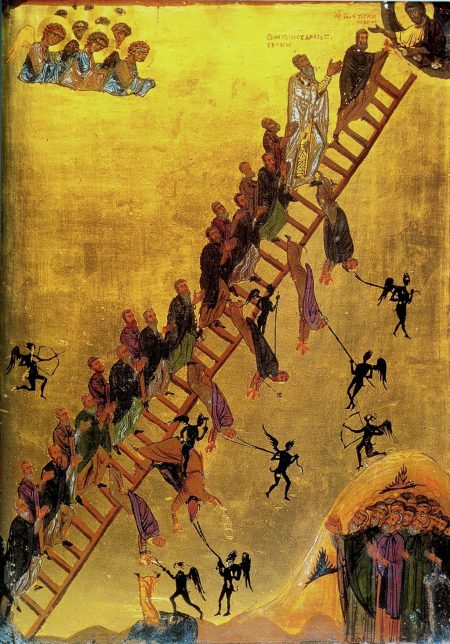
The seventh-century desert monk John Climacus was intellectually self-conscious. That’s a mental level above the artificial intelligence of a robot or the evolved programming of simple life-forms. Self-consciousness is a being’s mysterious ability to move to a point of view outside of itself and to think about itself as another being might do. John Climacus thought about himself in the conventional biblical categories of body/flesh and soul/spirit. In doing so, he perceived an intricate, conflicted self. That intricate, conflicted self remains relevant today to men seeking to climb the ladder from subordinate beings to beings intimate with God.
Gynocentric society teaches men that they are naturally demonic. Men self-consciously grappling with the demonic construction of men experience inner conflict:
By what rule or manner can I bind this body of mine? By what precedent can I judge him? Before I can bind him he is let loose, before I can condemn him I am reconciled to him, before I can punish him I bow down to him and feel sorry for him. How can I hate him when my nature disposes me to love him? How can I break away from him when I am bound to him forever? … How can I argue with him when all the arguments of nature are on his side?
Modern medicine offers men highly sophisticated male-to-female gender reassignment treatment. But that treatment cannot be successful for men who cannot overcome their self-identification as men by nature, even when they live within societies deeply gender-biased against men.
Under gynocentrism, men are divided between their social selves and their natural selves. The gynocentrically constructed self ponders the natural man:
He is my helper and my enemy, my assistant and my opponent, a protector and a traitor. I am kind to him and he assaults me. If I wear him out he gets weak. If he has a rest he becomes unruly. If I upset him he cannot stand it. If I mortify him I endanger myself. If I strike him down I have nothing left by which to acquire virtues. I embrace him. And I turn away from him.
What is this mystery in me? … How can I be my own friend and my own enemy? Speak to me! Speak to me, my yoke-fellow, my nature! I cannot ask anyone else about you. How can I remain uninjured by you? How can I escape the danger of my own nature?
The natural man responds:
I will never tell you what you do not already know. I will speak the knowledge we both have. … if you have learned the sure and rooted weakness within both you and me, you have manacled my hands. If you starve your longings, you have bound my feet , and they can travel no further. If you have taken up the yoke of obedience, you have cast my yoke aside. If you have taken possession of humility, you have cut off my head.
Men orienting themselves toward love of God must suppress their love of self and their longings, and practice obedience and humility in relation to God. Men, however, tend to confuse God with various goddesses — beautiful women, their wives, and the women who actually rule the mundane world. In relation to these goddesses, men must preserve their love of self, honor their own longings, and decisively reject obedience and humility, as well as castration culture. Victory in men’s inner conflicts and struggles isn’t merely one-sided.
Monks and other great men throughout history have heroically succeeded in rejecting gyno-idolatry and in loving women and God. As John Climacus recognized through his Ladder of Divine Ascent, progress is a matter of steps. Today, most men urgently need to take the first step. They must cultivate love of self in relation to the women they wrongly perceive to be goddesses. Then men can ascend to the next steps of pursuing their own interests and rejecting obedience and humility toward women-goddesses. Men must acquire a firm sense of themselves as having equal human dignity to women before they can hope to love women and God as fully human beings.
* * * * *
Read more:
- John Climacus endorsed Bishop Nonnus gazing on actress-dancer Pelagia
- Adam of Saint Victor and Le Tumbeor Nostre Dame
- beyond Origen: Jerome, spiritual doctor in Galen’s persona
Notes:
The above quotes are from John Climacus, Κλῖμαξ {Ladder of Divine Ascent}, from Step 15 (Περὶ ἁγνείας {On Chastity}), from Greek trans. Luidhéid & Russell (1982) pp. 185-6. Here’s the ancient Greek text (right column).
[image] The Ladder of Divine Ascent, as described by John Climacus. Twelfth-century icon in the Saint Catherine’s Monastery, Mount Sinai, Egypt. Image thanks to Pvasiliadis and Wikimedia Commons.
Reference:
Luibhéid, Colm and Norman Russell, trans. 1982. John Climacus: the Ladder of Divine Ascent. New York: Paulist Press.